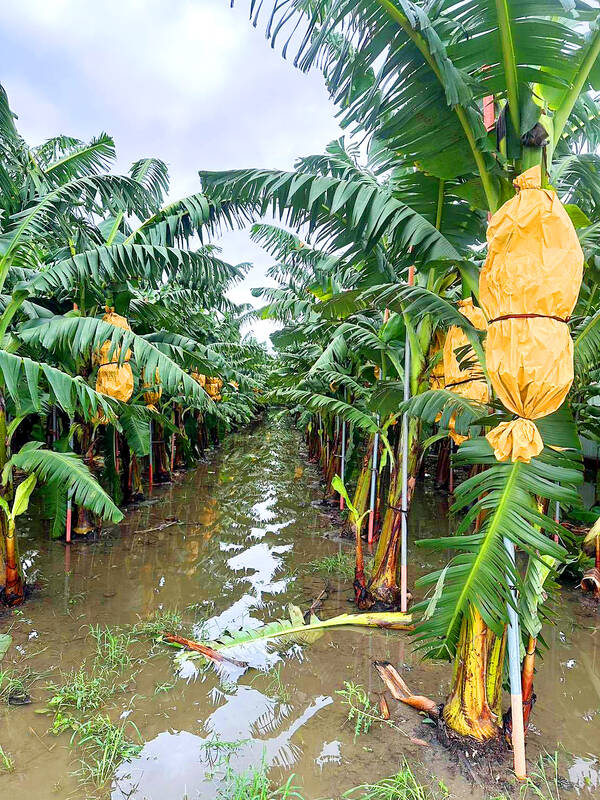Estimated agricultural losses caused by Typhoon Danas have climbed to nearly NT$1.1 billion (US$37.84 million), the Ministry of Agriculture (MOA) said yesterday.
As of 8am yesterday, crop damage had covered 9,822 hectares of farmland, more than 1.5 percent of Taiwan’s arable land, with an average loss rate of 30 percent, equivalent to 2,977 hectares of total crop failure, it said.
The most affected crop was pomeloes, with 923 hectares damaged at 51 percent, equivalent to 469 hectares of crop failure, and losses of up to NT$138.86 million.

Photo: Chen Wen-chan, Taipei Times
Other severely affected crops included bananas (NT$134.91 million), bamboo shoots (NT$83.27 million), oranges (NT$63.48 million) and tangerines (NT$55.18 million).
To aid recovery, the ministry has activated emergency cash relief and low-interest loan programs for the hardest-hit areas of Tainan, Chiayi County and Chiayi City.
For crops classified as severely damaged, on-site inspections have been waived to speed up assistance, the ministry said, adding that farmers lacking planting records may submit photographic evidence via the ministry’s disaster reporting app.
More than 400 offshore wind turbines were undamaged, while electricity was restored to more than 450,000 households affected by power outages, the Energy Administration and Taiwan Power Co (Taipower) said yesterday.
More than 400 wind turbines had been installed in the Taiwan Strait as of the end of May, with 375 connected to the grid, bringing the combined grid-connected capacity to more than 3 gigawatts, Energy Administration data showed.
The agency on Monday said it had previously instructed operators to regularly report turbine status and generation conditions as part of standard safety protocols. Following confirmation with operators, no turbine damage has been reported so far, it added.
In 2017, Taiwan and Japan jointly adopted a typhoon-resistance standard requiring offshore turbines to meet Class T specifications, agency officials said.
Under this standard, turbines are required to be able to withstand sustained wind speeds of 57 meters per second over 10 minutes — equivalent to a Beaufort scale 17 wind, or a typhoon — exceeding the strength required by Europe’s Class 1A standard, they said.
The turbines are designed to automatically shut down and lock their blades when wind speeds exceed 25 meters per second to prevent mechanical damage, the officials said.
Meanwhile, Taipower said that Typhoon Danas caused the collapse of more than 650 electricity poles and three transmission towers, cutting power to more than 710,000 households at the storm’s peak.
As of 6pm on Monday, power had been restored to more than 450,000 households — more than 60 percent of those affected, the company said.
Chiayi County and Chiayi City were among the hardest-hit areas, with more than 250,000 power outages reported, while nearly 190,000 households in Tainan also lost electricity, Taipower said.
More than 4,000 personnel were mobilized for emergency repairs, the company said.
Typhoon Danas made landfall late on Sunday in Chiayi County’s Budai Township (布袋) and weakened into a tropical storm early on Monday before moving north of Taiwan on Monday evening.
Wind gusts at a staffed station in Tainan reached 41.1 meters per second at 10:52pm on Sunday, the third-highest wind speed ever recorded at the city’s station, the Central Weather Administration said.
The storm left two people dead and injured 502.

US climber Alex Honnold is to attempt to scale Taipei 101 without a rope and harness in a live Netflix special on Jan. 24, the streaming platform announced on Wednesday. Accounting for the time difference, the two-hour broadcast of Honnold’s climb, called Skyscraper Live, is to air on Jan. 23 in the US, Netflix said in a statement. Honnold, 40, was the first person ever to free solo climb the 900m El Capitan rock formation in Yosemite National Park — a feat that was recorded and later made into the 2018 documentary film Free Solo. Netflix previewed Skyscraper Live in October, after videos

Starting on Jan. 1, YouBike riders must have insurance to use the service, and a six-month trial of NT$5 coupons under certain conditions would be implemented to balance bike shortages, a joint statement from transportation departments across Taipei, New Taipei City and Taoyuan announced yesterday. The rental bike system operator said that coupons would be offered to riders to rent bikes from full stations, for riders who take out an electric-assisted bike from a full station, and for riders who return a bike to an empty station. All riders with YouBike accounts are automatically eligible for the program, and each membership account

NUMBERS IMBALANCE: More than 4 million Taiwanese have visited China this year, while only about half a million Chinese have visited here Beijing has yet to respond to Taiwan’s requests for negotiation over matters related to the recovery of cross-strait tourism, the Tourism Administration said yesterday. Taiwan’s tourism authority issued the statement after Chinese-language daily the China Times reported yesterday that the government’s policy of banning group tours to China does not stop Taiwanese from visiting the country. As of October, more than 4.2 million had traveled to China this year, exceeding last year. Beijing estimated the number of Taiwanese tourists in China could reach 4.5 million this year. By contrast, only 500,000 Chinese tourists are expected in Taiwan, the report said. The report

Temperatures are forecast to drop steadily as a continental cold air mass moves across Taiwan, with some areas also likely to see heavy rainfall, the Central Weather Administration (CWA) said. From today through early tomorrow, a cold air mass would keep temperatures low across central and northern Taiwan, and the eastern half of Taiwan proper, with isolated brief showers forecast along Keelung’s north coast, Taipei and New Taipei City’s mountainous areas and eastern Taiwan, it said. Lows of 11°C to 15°C are forecast in central and northern Taiwan, Yilan County, and the outlying Kinmen and Lienchiang (Matsu) counties, and 14°C to 17°C